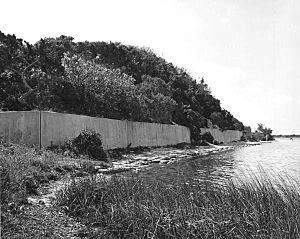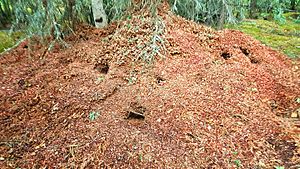Midden facts for kids
A midden is like an ancient garbage dump. It's a pile of waste left behind by people who lived long ago. These piles can contain all sorts of things, such as animal bones, shells from seafood, broken pottery, and stone tools.
Archaeologists love middens! They are very useful because they show what people ate and how they lived. If the midden is in a damp place with little air, it can even keep organic things like food scraps or old tools from decaying. Each time someone threw something onto the pile, it added to the story. Over time, dirt and other natural materials also got mixed in. This helps scientists learn about the weather and seasons from the past.
Contents
What Are Shell Middens?
A shell midden is a special type of midden made mostly of mollusk shells. These are often found near coasts or lakes. The Danish word køkkenmøddinger (which means "kitchen mounds") was first used to describe these shell heaps. It's important not to confuse shell middens with natural piles of shells made by wind or tides.
Some shell middens were places where people cleaned and prepared seafood right after they caught it. Others were simply the main garbage dump for a village. Sometimes, each house in a village had its own small midden right outside. No matter how they were formed, shell middens are very complex. They hold a lot of clues about what people ate and the tools they used, making them very important for archaeologists to study.
Shells contain a lot of calcium carbonate. This makes the middens alkaline, which means they are not acidic. This helps slow down the normal decay of organic materials. So, archaeologists can often find well-preserved food remains, wooden tools, clothing, and even human remains in shell middens.
Shell Midden Discoveries
One of the first archaeological digs of a shell midden happened in Tokyo, Japan, in 1877. A scientist named Edward Sylvester Morse studied the Omori Shell Mounds. He discovered a type of pottery with cord marks, which was named "Jōmon." This name is now used for an early period of Japanese history when this pottery was made.
Shell middens were also studied a lot in Denmark in the late 1800s. This is where the term køkkenmødding (kitchen mound) became well-known around the world. The English word "midden" comes from a similar old word that means "waste mound."
Examples Around the World
Shell middens are found all over the world, usually along coasts or lakeshores. They are mostly made of mollusk shells and show where ancient people ate their meals. Some are small, from just a few people eating. Others are huge, many meters long and wide, showing centuries of shell dumping.
In Brazil, large shell middens are called sambaquis. They were built over thousands of years, from about 6000 BCE until Europeans arrived.
On Canada's west coast, some shell middens stretch for over 1 kilometer (0.6 miles) along the shore and are several meters deep. The midden in Namu, British Columbia, is over 9 meters (30 feet) deep and shows that people lived there for more than 10,000 years!
Indigenous Australians also created shell middens along the coasts of Australia. These middens are important because they prove that people lived there long ago. They are often protected from mining and other building projects. Some shell middens are even considered sacred places, linked to ancient stories and beliefs.
In Florida, USA, some shell middens helped create high, dry areas in wet landscapes. For example, the Otter Mound Preserve was formed by shell deposits from the Calusa people. These mounds provided dry land in areas that were otherwise often flooded.
Some shell mounds are shaped like circles or open arcs with a clear space in the middle. These are called shell rings. Many of them are found in Japan and the southeastern United States, and at least one is in South America.
Middens in the Animal Kingdom
Animals also create middens! Some animals, like the North American red squirrel, make middens mainly for storing food. These are often large piles of pine cones or other food items.
Other animals use middens as a regular toilet area or a dung heap. Many mammals, such as the hyrax, do this. These animal middens can also act as a way to mark their territory.
Octopuses also make middens. They pile up rocks, shells, and bones of their prey to hide the entrance to their dens. They will use almost anything they can move to build their midden.
Images for kids
See also
 In Spanish: Conchero para niños
In Spanish: Conchero para niños





